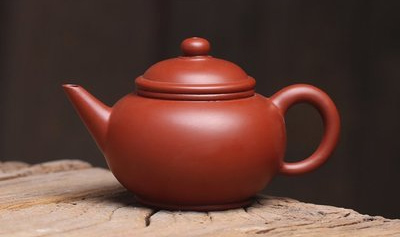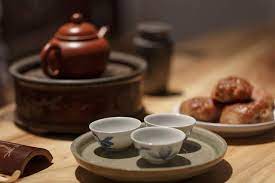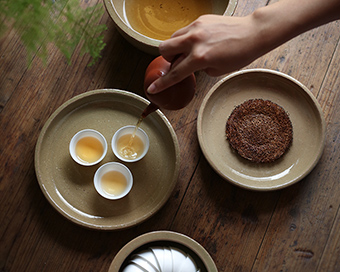Introduction:
Cháozhōu 潮州 is a city in Guǎngdōng 廣東 Province, China, in the Cháoshàn 潮汕 area. There are the so-called Phoenix Mountains (Fènghuángshān 鳳凰山), where the famous dāncōng wūlóng 單樅烏龍 tea is produced.
This region is one of the cradles of Chinese tea culture, where some believe the gōngfū chá (工夫茶 or 功夫茶) ceremony originated several hundred years ago, and from where it would have spread to the rest of China. However, this ceremony differs in some respects from that practiced in other regions of the country.
Although today the Chinese usually refer to gōngfū chá with the characters 功夫茶, the inhabitants of Cháozhōu still refer to it as 工夫茶 (read ganghu dê in the Cháozhōu dialect). These characters, 工 and 功, which in the Cháozhōu dialect are pronounced differently (gang 工 and gong 功), in both Cantonese and Mandarin Chinese are homophones. Locals of Cháozhōu maintain that the original term is 工夫茶, with 功夫茶 being a modern denomination.
Still, it's hard to say. The meaning of both expressions varies little, 工夫 referring more to work and time, to a laborious and arduous process, and 功夫 emphasizing more the skill required in this process. Together, both 工夫茶 and 功夫茶 can be translated as "skillfully brewing tea."

The tea ceremony of Chaozhou:
Unlike in the rest of China, where a gōngdàobēi 公道杯 is also used, in Cháozhōu and Cháoshàn only one teapot and three cups are used, regardless of the diners. Although today the teapot can come from different regions, it is common to continue using local ceramic teapots, characteristic for their color and shape. The use of gàiwǎn 蓋碗 is also common.

Typical Cháozhōu 潮州 teapot.
Also, in the past, the tea consumed in Cháozhōu was the same locally produced tea, i.e. the dāncōng wūlóng of the Phoenix mountain range, although today teas from other sources are available and consumed with equal frequency.
As usual, after heating the water and accessories, the tea leaves are placed in the teapot and "washed" by pouring hot water. This first infusion is usually discarded, fulfilling the purpose of "awakening" the leaf and preparing it to extract its components in the following brews. Subsequently, the teapot is filled again with hot water, letting the leaves release their flavour and their properties in it.
To evenly distribute the tea in the cups, in the absence of gōngdàobēi, the tea must be served in a circular manner. To do this, the three cups are placed together, forming the character pǐn 品, "taste". This character is said to symbolize in abbreviated form the word pǐndé 品德, which means "virtuous character" or "morality".

Arrangement of the cups.
Arranged the cups, the tea is poured describing circles with the pot, passing from one cup to another without interruption and passing again while still pouring the liquid until the teapot is emptied. In this way, the liquid of the infusion is distributed equally between the cups, without there being differences in the concentration of the infusion between one cup and another, as would happen if they were served one by one.
This circular way of serving tea is known as "Lord Guān patrols the city" (關公巡城 Guāngōng xún chéng). This name alludes to the famous general of the Three Kingdoms period, Guān Yǔ 關羽, making a round around a walled fortress. Generally, tea should be served in cups in three or four circles at most.

When the teapot is almost empty, it is shaken slightly with downward movements to distribute the last drops, which have the strongest liquor, from one cup to another, drop by drop. This is known as "Hán Xìn selects the troops" (韓信點兵 Hán Xìn diǎn bīng). Hán Xìn was another very famous general of antiquity, who contributed to the formation of the Hàn 漢 dynasty, serving under whom would be its first emperor.
Once the tea is served in the cups, the first of these must be offered to the oldest guest, and that order of age is followed as a sign of respect. This is called xiān zūn hòu bēi, xiān lǎo hòu yòu 先尊後卑、先老後幼, literally "first the respectable [person], then the lower [person]; first the old, then the young". Although it is also to be considered to serve the guest first before the host (xiānkè hòu zhǔ, sīlú zuì mò 先客後主,司爐最末). If this is not thus done, it is considered disrespectful and it is said that "the barbarian host deceives the guests" (mán zhǔ qī kè 蠻主欺客).

When drinking from the cup, tea is traditionally drank in three sips, the first to appreciate the aroma and moisten the lips; the second to appreciate the flavour well and the third to keep a final aftertaste. After the third sip, if there is a residue in the cup, it is poured into the tea tray.
According to tradition, when there are more than three people, tea is drank in rounds, washing the cups with hot water before making another infusion and offering the tea to the next three people, following the protocol order. However, at present the three-cup system remains only in the private or domestic sphere, being used in the rest of situations as many cups as people.
